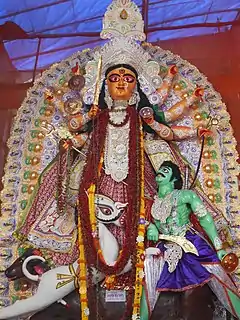Shakta Rash
Shakta Rash or Shakta Rasa or Shakta Ras (Bengali: শাক্তরাস) is the most celebrated festivals of Nabadwip, West Bengal, India. This festival is celebrated thirty-five days after the autumnal Durgapuja celebration or fifteen days after Kali puja in Kartik Purnima. To the people of Nabadwip Rash Festival is everything. The entire commonwealth eagerly wait for this festival all year round.[1]
| Shakta Rash | |
|---|---|
 Dumureshbri mata in Nabadwip Rash Jatra | |
| Also called | Pot Purnima, Rash-Kali Puja, Rash Jatra |
| Observed by | Bangali Shakta Hindu |
| Type | Bangali Shakta Hindu |
| Celebrations | Puja, Boli in some place, Arong, the immersing of idols |
| Observances | To make idols with clay and to worship Shakti in Kartik Purnima |
| Begins | Beginning with Pata Puja and started after Durga puja and Lakshmi puja |
| Ends | After Rash Purnima or Kartik Purnima with celebrating immersion named Arong[1] |
| Date | 30 November (2020) 19 November (2021) according to Bengali calendars |
The main features of the Nabadwip Rash are to make huge idols with clay and to worship Shakti. Every idol has an artistic design, a variety of imagination, religious discourse, and deep understanding of the scholars, which help entertain innumerable people.[2] Cartoonist Chandi Lahiri said that hugeness of clay idols differs from any other festival as Nabadwip's idols are shapely and symmetric despite their light weight.
Historical groundings
Ras festival mainly part of Vaishnavism. In the time of Chaitanya deb or some years earlier, Rash Yatra was started in Nabadwip. But it was Vaishnabic festival. Shakta ras is totally different from that. Sakta Ras festival may be older than Vaishnava Ras, because in the beginning, idols were worshipped in Patachitra. During the time of Krishnachandra and mainly Girishchandra, Nabadwip Rash yatra became popular. Krishna Chandra and Girishchandra spent much money to popularise the festival and since then worshipping started through clay idol.[3]
Girish Chandra Basu highlighted the first glimpse of Nabadwip Ras. In 1853–1860, he was a daroga of Nabadwip-Shantipur and Krishnanagar. In his book Sekaler Daroga Kahini (published 1888 AD), he wrote various socio-cultural reports along with the geographical location of the Nabadwip of that time.[4]
Kali puja and Ras festival
Nabadwip is a sanctum of Tantra. Many Shakta and Tantra philosophers worshipped Devi kali even before the Shakta Ras Festival began. Later these Kali idols were worshipped in Ras festival. Fundamentalism of Brahmin led other people to turn towards Tantra. Since the twelfth or fourteenth century, tantra has been enriched with tendance of Tantra philosophers throughout Bengal.
Conflict with Vaishnavism
In the early 16th century, some Vaishnabic scholars started the Vaishnabic movement. So it was an obvious conflict with Shakta followers who were worshipping Tantra.
Shakta ras in early days
Documentation of early days of Shakta ras is very rare as flood and earthquake hit several times. Although Girish Chandra Basu and Kanti Chandra Rari gave glimpse of Shakta ras in early days.
Girish Chandra Basu
Girish Chandra Basu, Daroga of Nabadwip-Shantipur-Krishnagar, wrote "Sekaler Daroga Kahini, where he described socio-cultural view of Nadia. He wrote,
During ras utsav people were gathered in Shantipur, similarly in Nabadwip lots of people came to see Potpuja and various cultural programme is being held. This Potpuja is famous in Nabadwip. Though its name is Potpuja but actually worshiping has done through making clay idol of various deity. Among them, Durga, Bindhyabasini, Kali, Jagadhatri, Annapurna were very famous. This idol are very light weighted. Five or six people can easily bear in the shoulder, even they can easily dance with it.
Description
Girish Babu's description gives an idea about 19th century Ras utsav. Bindhyobasini was worshiped in Purangunge. This place is now ruined. In 1853-60 he saw Purangunge in right place. After that in 1871 Purangunge was ruined by Ganga due to erosion. Then Bindhyabasini deity transferred to Sribasangan. But due to some internal problem puja committee had split into two organising committees. And one committee worshiped Bindhyabasini in Sribasangan and other one started Gourangini puja near Jognathtala.
Kanti Chandra Rari
Historian Kanti Chandra Rari also wrote about Nabadwip Ras in his book Nabadwip Mahima. There he confirmed that Shakta Ras jatra had been celebrated since long year back. He wrote,
Superpower of Hindu mythology, Devi Bhagabati has been worshipped in different form in Nabadwip during Ras Purnima. Next day after puja, people from the nearest place came to watch idols. Also Maharaja of Nadia came to see and he encouraged this festival by giving award for making outstanding idol. For that purpose an organising committee brought there idol in Porama tala. There Maharaj judges the structure of idol, ornaments (called in Bengali as Saj, সাজ) etc and then decided the award to best one.
Glory of the idols
Cartoonist Chandi Lahiri said about the glory of the idols worshiped in Nabadwip Rash jatra,[5][6]
Nabadbīpēra mūrtira biśālatbēra madhyē'ō pratiṭi anśēra suṣamā akṣunna rākhā, bibhinna dēbatāra śāstrīẏa kalpanākē māṭira sāhāyyē bāstabē rūpāẏita karā biśbēra yē kōna dēśēra pakṣē yugapaṯ bismaẏa ō gaurabēra bastu
References
| Wikimedia Commons has media related to Nabadwip Shakta Ras Jatra. |
- সংবাদদাতা, নিজস্ব. "রাসে পরিবর্তনের ছোঁয়া, খুশি নবদ্বীপ - Anandabazar". Anandabazar Patrika (in Bengali). Retrieved 2018-07-06.
- "About Rash/History - Nabadwip, oxford of old east". sites.google.com. Retrieved 2017-12-22.
- Nadia Kahini, addition, pg-372
- Basu, Girish Chandra. সেকালের দারোগা কাহিনী (Sekaler Daroga Kahini).
- Mrityunjoy Mandal (January 2013). Nabadwiper Itibritto. Nabadwip, Nadia: NABADWIP SAHITYO SAMAJ. p. 157.
- Rashmi published by Nabadwip Adarsha Pathagar, January 1997, pg: 86-86
